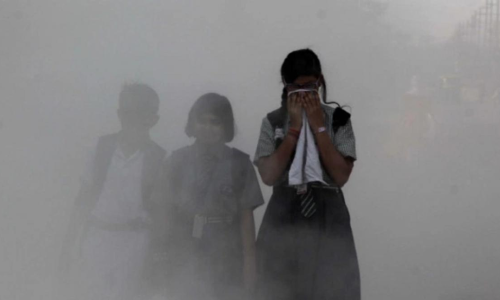Live
- MITS faculty awarded with PhD by VTU
- Sannapureddy takes charge as RTC regional chairman
- Improve state of public parks, civic chief instructs officials
- Education Minister doesn’t know Kannada
- MSMEs churn 10-cr jobs in 15 months
- Tammineni busy consulting followers
- Manoj Kumar Sahoo new DRM of Waltair Division
- Career aspirants encouraged to stay focused on their goals
- Need for skills in pharmacy stressed
- Free entry to Visakha Museum on November 24
Just In

The findings of an earlier study had shown that 20 per cent of a child\'s daily dose of black carbon is inhaled during urban commutes.
Exposure to air pollution on the way to school can have damaging effects on growth of children's working memory, suggests new research.
The study, published in the journal Environmental Pollution, found an association between a reduction in working memory and exposure to fine particulate matter (PM2.5) -- fine inhalable particles that have diameters of 2.5 micrometres or less -- and black carbon -- a pollutant directly related to traffic -- during the walking commute to and from school.
The findings of an earlier study had shown that 20 per cent of a child's daily dose of black carbon is inhaled during urban commutes.
"The results of earlier toxicological and experimental studies have shown that these short exposures to very high concentrations of pollutants can have a disproportionately high impact on health" said first author of the study Mar Alvarez-Pedrerol, researcher at Barcelona Institute for Global Health (ISGlobal) in Spain.
"The detrimental effects may be particularly marked in children because of their smaller lung capacity and higher respiratory rate," she added.
The study was carried out in Barcelona and enrolled over 1,200 children aged from 7 to 10, from 39 schools, all of whom walked to school on a daily basis.
The children's working memory and attention capacity was assessed several times during the 12-month study.
Their exposure to air pollution over the same period was calculated on the basis of estimated levels on the shortest walking route to their school.
Statistical analysis of the findings revealed that exposure to PM2.5 and black carbon was associated with a reduction in the growth of working memory.
An interquartile range increase in PM 2.5 and black carbon levels was associated with a decline of 4.6 per cent and 3.9 per cent, respectively, in expected annual growth of working memory, the study said.
The interquartile range (IQR) is a measure of variability based on dividing a data set into quartiles.
"The fact that children who walk to school may be more exposed to pollution does not mean that children who commute by car or on public transport are not also exposed to high levels," said Jordi Sunyer, head of ISGlobal's Child Health Programme. and co-author of the study.
"The solution is the same for everyone: reduce the use of private vehicles for the school run and create less polluted and safer home-to-school routes," Alvarez-Pedrerol said.

© 2024 Hyderabad Media House Limited/The Hans India. All rights reserved. Powered by hocalwire.com







